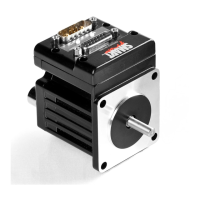Moog Animatics SmartMotor™ Developer's Guide,Rev. L
Page 127 of 909
Example 2
The motor is faulted due to any typical fault, such as travel limits, overcurrent, overtemp etc.
The brake should already be mechanically engaged regardless of the mode (BRKTRJ or
BRKSRV), and provided no manual override commands were issued since the fault occurred.
Given the above precondition, the following could be done:
l
If BRKENG is issued, the brake will stay engaged; then issue BRKTRJ, the brake will stay
engaged.
l
If BRKRLS is issued, the brake will release (even though the motor is faulted because a
manual override command was just issued); you then issue BRKTRJ, the brake will
engage because the trajectory bit is off due to the fact that the motor is faulted.
l
If the motor was in BRKTRJ and BRKSRV is issued, the brake will remain mechanically
engaged.
l
If the motor was in BRKSRV and BRKTRJ is issued, the brake will remain mechanically
engaged.
Example 3:
If the motor is moving or holding position, and the Trajectory bit is ON, and no manual
override commands have been issued — regardless of modes BRKSRV or BRKTRJ, the brake
will be mechanically disengaged.
l
If BRKENG is issued and the motor is NOT moving, the brake will engage.
l
If BRKENG is issued and the motor IS moving, the brake will engage causing the motor
to mechanically be loaded to the point of stopping and faulting out.
EOBK(IO)
Reroute Brake Signal to I/O
When the automated brake functions are desired for an external brake, this command can be
used to choose a specified I/O port. This corresponds to the same I/O pin numbering used by
other I/O commands. These commands re-route the internal brake signal to the respective
I/O pins. The brake signal is active high to engage the brake to the shaft on the pulled-up 5
Volt I/O. On the 24 Volt I/O, the default state is off (0 Volts), so the brake engages the shaft
when the 24 Volt signal is low. The EOBK(-1) command removes the brake function from any
external I/O. Only one pin can be used as the brake pin at any one time. Therefore, each
command supersedes the other.
For the M-style SmartMotor, only output 8 works for that motor. Therefore, the values are:
l
EOBK(8) to enable
l
EOBK(-1) to disable
MTB
Mode Torque Brake
Mode Torque Brake is the default state on power-up. It causes the motor control circuits to tie
the three phases of the motor together as a form of dynamic braking. For a fault or the OFF
command, instead of the motor coasting to a stop, it abruptly stops. This is not done by
servoing the motor to a stop, but by simply shorting all of the coils to ground. If there is a
constant torque on the motor, it allows only very slow movement of the shaft.
Part 1: Programming: EOBK(IO)

